Effects of swimming training on myocardial protection in rats
- Authors:
- Chang-Chi Lai
- Chia-Yu Tang
- Szu-Kai Fu
- Wei-Chin Tseng
- Kuo-Wei Tseng
-
Affiliations: Department of Exercise and Health Sciences, University of Taipei, Taipei 11153, Taiwan, R.O.C., Department of Physical Education, Chang Gung University, Taoyuan 33302, Taiwan, R.O.C., Graduate Institute of Sports Training, University of Taipei, Taipei 11153, Taiwan, R.O.C. - Published online on: January 31, 2022 https://doi.org/10.3892/br.2022.1502
- Article Number: 19
-
Copyright: © Lai et al. This is an open access article distributed under the terms of Creative Commons Attribution License.
This article is mentioned in:
Abstract
 |
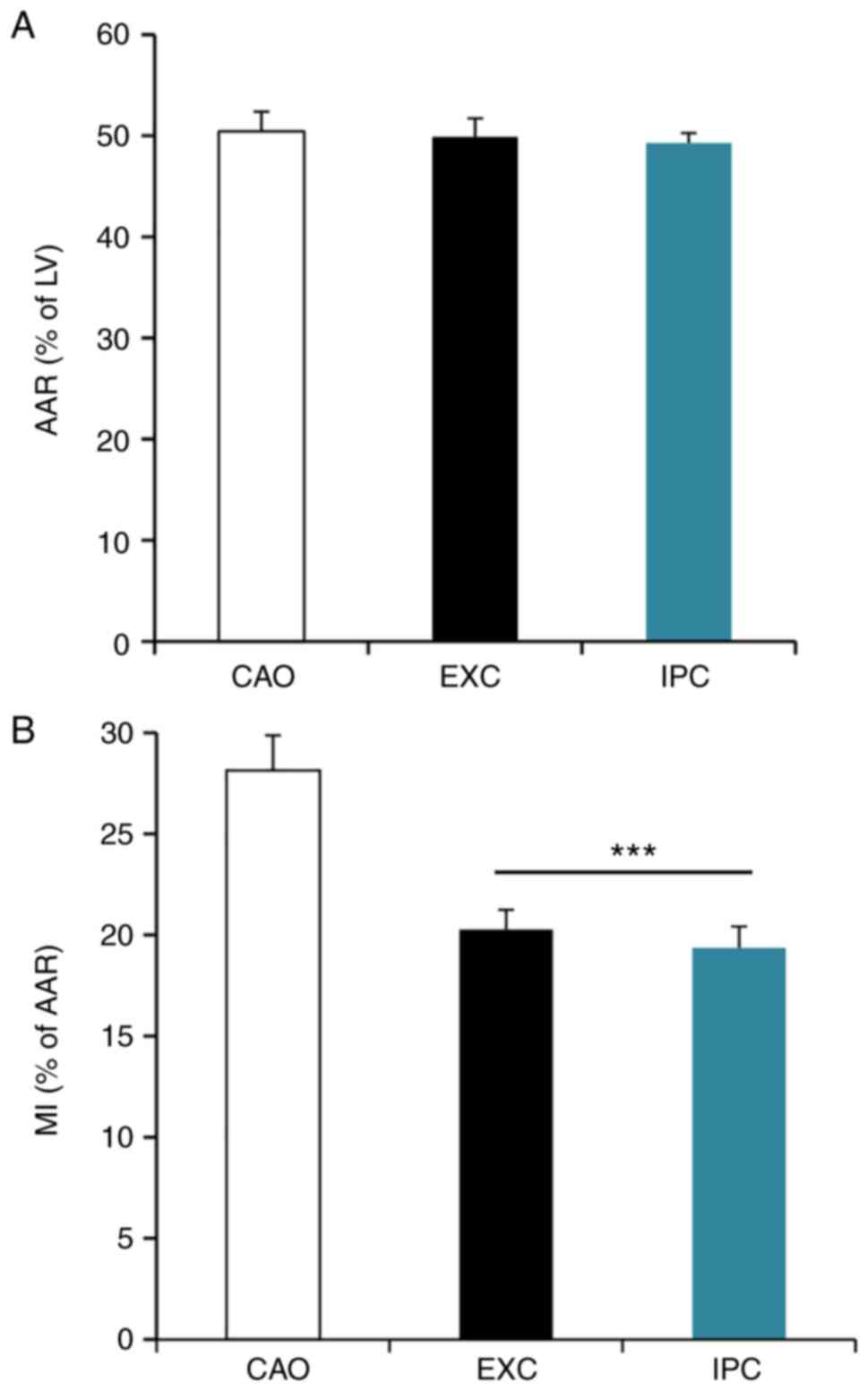 |
 |
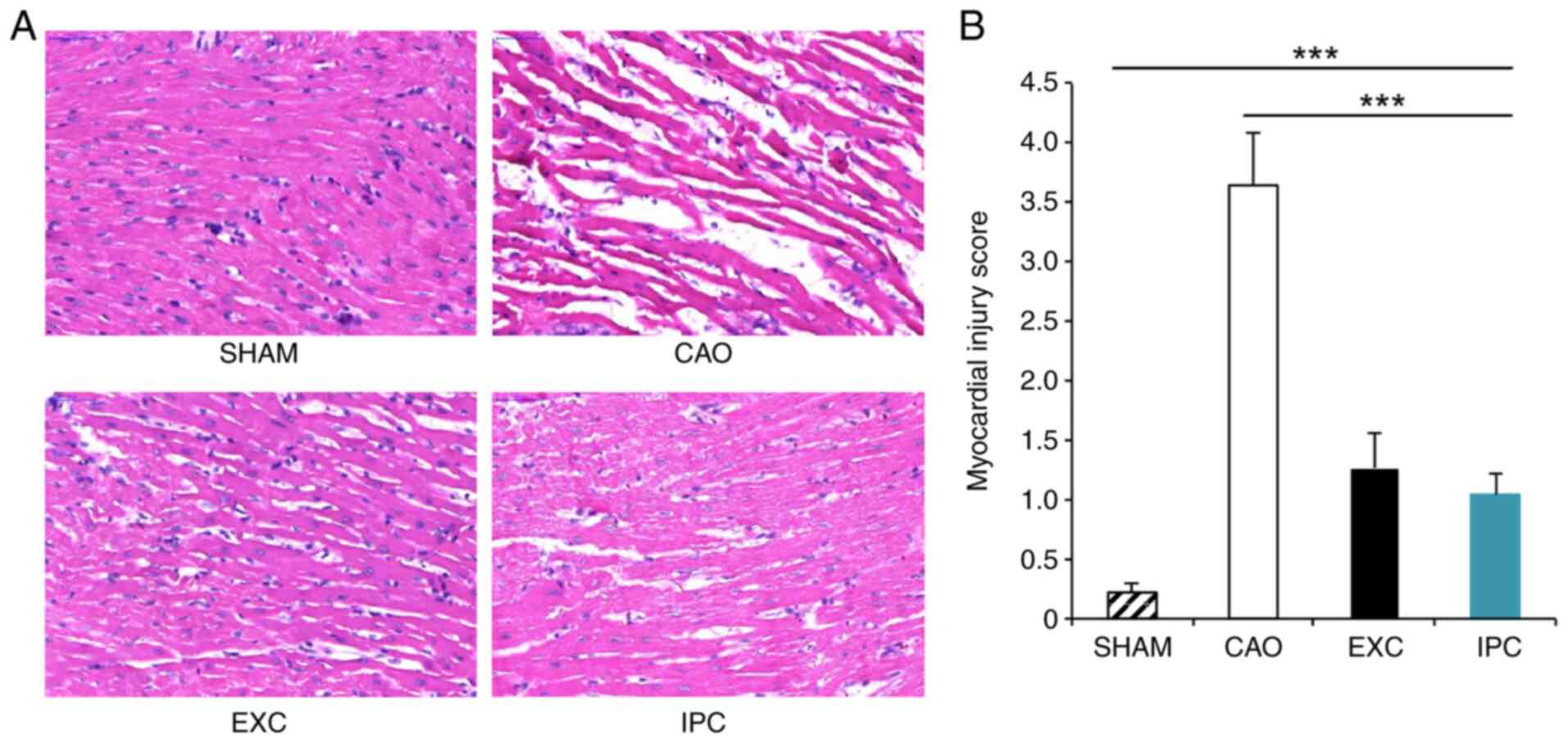 |
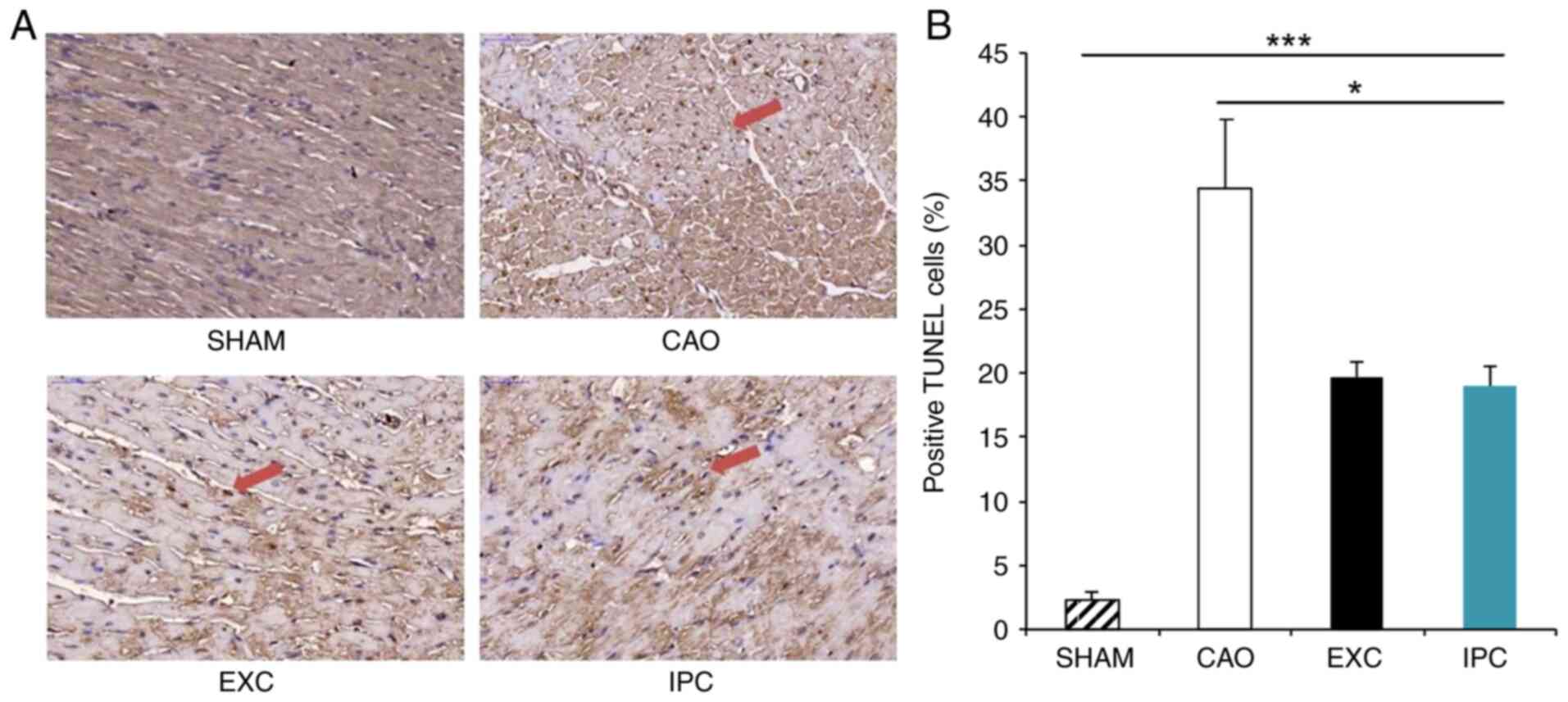 |
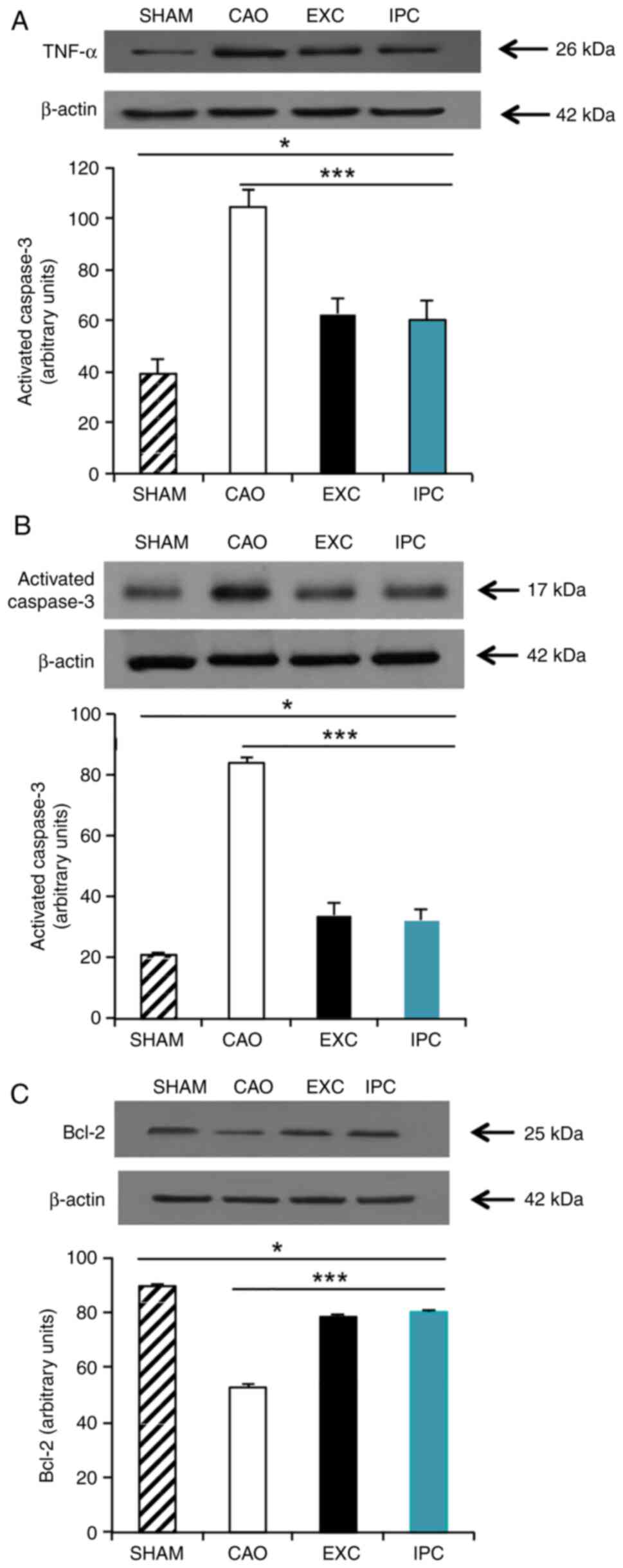 |
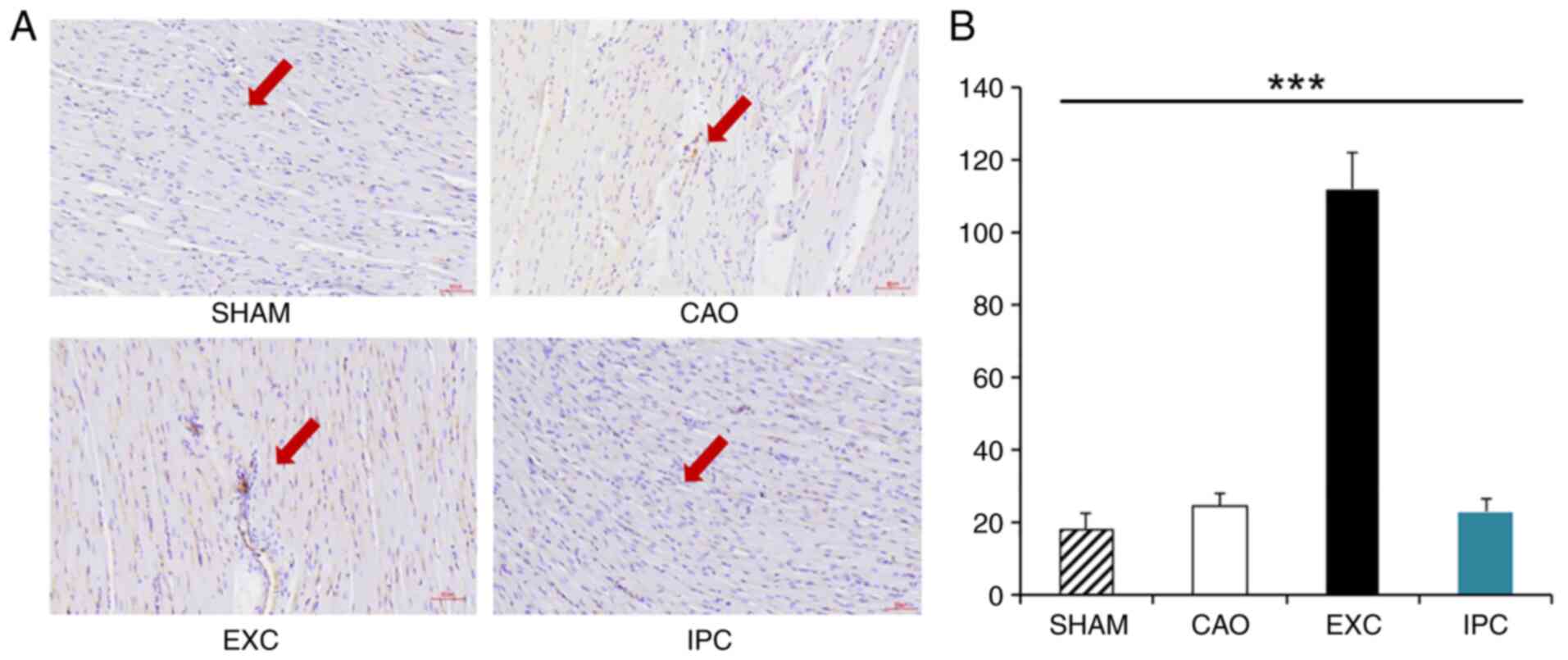 |
|
Balakumar P, Maung UK and Jagadeesh G: Prevalence and prevention of cardiovascular disease and diabetes mellitus. Pharmacol Res. 113:600–609. 2016.PubMed/NCBI View Article : Google Scholar | |
|
Nowbar AN, Gitto M, Howard JP, Francis DP and Al-Lamee R: Mortality from ischemic heart disease. Circ Cardiovasc Qual Outcomes. 12(e005375)2019.PubMed/NCBI View Article : Google Scholar | |
|
Patterson SW and Starling EH: On the mechanical factors which determine the output of the ventricles. J Physiol. 48:357–379. 1914.PubMed/NCBI View Article : Google Scholar | |
|
Buja LM: Myocardial ischemia and reperfusion injury. Cardiovasc Pathol. 14:170–175. 2005.PubMed/NCBI View Article : Google Scholar | |
|
Singhal AK, Symons JD, Boudina S, Jaishy B and Shiu YT: Role of endothelial cells in myocardial ischemia-reperfusion injury. Vasc Dis Prev. 7:1–14. 2010.PubMed/NCBI View Article : Google Scholar | |
|
Sheehan FH, Doerr R, Schmidt WG, Bolson EL, Uebis R, von Essen R, Effert S and Dodge HT: Early recovery of left ventricular function after thrombolytic therapy for acute myocardial infarction: An important determinant of survival. J Am Coll Cardiol. 12:289–300. 1988.PubMed/NCBI View Article : Google Scholar | |
|
Reeve JL, Duffy AM, O'Brien T and Samali A: Don't lose heart-therapeutic value of apoptosis prevention in the treatment of cardiovascular disease. J Cell Mol Med. 9:609–622. 2005.PubMed/NCBI View Article : Google Scholar | |
|
Bolli R and Marbán E: Molecular and cellular mechanisms of myocardial stunning. Physiol Rev. 79:609–634. 1999.PubMed/NCBI View Article : Google Scholar | |
|
Basso C and Thiene G: The pathophysiology of myocardial reperfusion: A pathologist's perspective. Heart. 92:1559–1562. 2006.PubMed/NCBI View Article : Google Scholar | |
|
Ruiz-Meana M, Abellán A, Miró-Casas E and Garcia-Dorado D: Opening of mitochondrial permeability transition pore induces hypercontracture in Ca2+ overloaded cardiac myocytes. Basic Res Cardiol. 102:542–552. 2007.PubMed/NCBI View Article : Google Scholar | |
|
Argaud L, Loufouat J, Gateau-Roesch O, Gomez L, Robert D and Ovize M: Persistent inhibition of mitochondrial permeability transition by preconditioning during the first hours of reperfusion. Shock. 30:552–556. 2008.PubMed/NCBI View Article : Google Scholar | |
|
Ishida T, Yarimizu K, Gute DC and Korthuis RJ: Mechanisms of ischemic preconditioning. Shock. 8:86–94. 1997.PubMed/NCBI View Article : Google Scholar | |
|
Gross ER and Gross GJ: Ischemic preconditioning and myocardial infarction: An update and perspective. Drug Discov Today Dis Mech. 4:165–174. 2007.PubMed/NCBI View Article : Google Scholar | |
|
Murry CE, Jennings RB and Reimer KA: Preconditioning with ischemia: A delay of lethal cell injury in ischemic myocardium. Circulation. 74:1124–1136. 1986.PubMed/NCBI View Article : Google Scholar | |
|
Vegh A, Szekeres L and Parratt JR: Transient ischaemia induced by rapid cardiac pacing results in myocardial preconditioning. Cardiovasc Res. 25:1051–1053. 1991.PubMed/NCBI View Article : Google Scholar | |
|
Cumming DV, Heads RJ, Brand NJ, Yellon DM and Latchman DS: The ability of heat stress and metabolic preconditioning to protect primary rat cardiac myocytes. Basic Res Cardiol. 91:79–85. 1996.PubMed/NCBI View Article : Google Scholar | |
|
Huang CH, Kim SJ, Ghaleh B, Kudej RK, Shen YT, Bishop SP and Vatner SF: An adenosine agonist and preconditioning shift the distribution of myocardial blood flow in conscious pigs. Am J Physiol. 276:H368–H375. 1999.PubMed/NCBI View Article : Google Scholar | |
|
Schott RJ, Rohmann S, Braun ER and Schaper W: Ischemic preconditioning reduces infarct size in swine myocardium. Circ Res. 66:1133–1142. 1990.PubMed/NCBI View Article : Google Scholar | |
|
Liu GS, Thornton J, Van Winkle DM, Stanley AW, Olsson RA and Downey JM: Protection against infarction afforded by preconditioning is mediated by A1 adenosine receptors in rabbit heart. Circulation. 84:350–356. 1991.PubMed/NCBI View Article : Google Scholar | |
|
Li Y and Kloner RA: The cardioprotective effects of ischemic ‘preconditioning’ are not mediated by adenosine receptors in rat hearts. Circulation. 87:1642–1648. 1993.PubMed/NCBI View Article : Google Scholar | |
|
Sumeray MS and Yellon DM: Ischaemic preconditioning reduces infarct size following global ischaemia in the murine myocardium. Basic Res Cardiol. 93:384–390. 1998.PubMed/NCBI View Article : Google Scholar | |
|
Wilmore JH: Aerobic exercise and endurance: Improving fitness for health benefits. Phys Sportsmed. 31:45–51. 2003.PubMed/NCBI View Article : Google Scholar | |
|
Swain DP and Franklin BA: Comparison of cardioprotective benefits of vigorous versus moderate intensity aerobic exercise. Am J Cardiol. 97:141–147. 2006.PubMed/NCBI View Article : Google Scholar | |
|
Khot UN, Khot MB, Bajzer CT, Sapp SK, Ohman EM, Brener SJ, Ellis SG, Lincoff AM and Topol EJ: Prevalence of conventional risk factors in patients with coronary heart disease. JAMA. 290:898–904. 2003.PubMed/NCBI View Article : Google Scholar | |
|
Lawson WE, Hui JC, Zheng ZS, Burgen L, Jiang L, Lillis O, Oster Z, Soroff H and Cohn P: Improved exercise tolerance following enhanced external counterpulsation: cardiac or peripheral effect? Cardiology. 87:271–275. 1996.PubMed/NCBI View Article : Google Scholar | |
|
Demirel HA, Powers SK, Zergeroglu MA, Shanely RA, Hamilton K, Coombes J and Naito H: Short-term exercise improves myocardial tolerance to in vivo ischemia-reperfusion in the rat. J Appl Physiol (1985). 91:2205–2212. 2001.PubMed/NCBI View Article : Google Scholar | |
|
Perrault H and Turcotte RA: Exercise-induced cardiac hypertrophy. Fact or fallacy? Sports Med. 17:288–308. 1994.PubMed/NCBI View Article : Google Scholar | |
|
Jin H, Yang R, Li W, Lu H, Ryan AM, Ogasawara AK, Van Peborgh J and Paoni NF: Effects of exercise training on cardiac function, gene expression, and apoptosis in rats. Am J Physiol Heart Circ Physiol. 279:H2994–H3002. 2000.PubMed/NCBI View Article : Google Scholar | |
|
McElroy CL, Gissen SA and Fishbein MC: Exercise-induced reduction in myocardial infarct size after coronary artery occlusion in the rat. Circulation. 57:958–962. 1978.PubMed/NCBI View Article : Google Scholar | |
|
Bowles DK, Farrar RP and Starnes JW: Exercise training improves cardiac function after ischemia in the isolated, working rat heart. Am J Physiol. 263:H804–H809. 1992.PubMed/NCBI View Article : Google Scholar | |
|
Gul M, Demircan B, Taysi S, Oztasan N, Gumustekin K, Siktar E, Polat MF, Akar S, Akcay F and Dane S: Effects of endurance training and acute exhaustive exercise on antioxidant defense mechanisms in rat heart. Comp Biochem Physiol A Mol Integr Physiol. 143:239–245. 2006.PubMed/NCBI View Article : Google Scholar | |
|
Freimann S, Scheinowitz M, Yekutieli D, Feinberg MS, Eldar M and Kessler-Icekson G: Prior exercise training improves the outcome of acute myocardial infarction in the rat: Heart structure, function, and gene expression. J Am Coll Cardiol. 45:931–938. 2005.PubMed/NCBI View Article : Google Scholar | |
|
Ozturk N, Olgar Y, Er H, Kucuk M and Ozdemir S: Swimming exercise reverses aging-related contractile abnormalities of female heart by improving structural alterations. Cardiol J. 24:85–93. 2017.PubMed/NCBI View Article : Google Scholar | |
|
Nagaraja HS and Jeganathan PS: Forced swimming stress-induced changes in the physiological and biochemical parameters in albino rats. Indian J Physiol Pharmacol. 43:53–59. 1999.PubMed/NCBI | |
|
Popgeorgiev N, Sa JD, Jabbour L, Banjara S, Nguyen TTM, Akhavan-E-Sabet A, Gadet R, Ralchev N, Manon S, Hinds MG, et al: Ancient and conserved functional interplay between Bcl-2 family proteins in the mitochondrial pathway of apoptosis. Sci Adv. 6(eabc4149)2020.PubMed/NCBI View Article : Google Scholar | |
|
Chou PL, Chen KH, Chang TC and Chien CT: Repetitively hypoxic preconditioning attenuates ischemia/reperfusion-induced liver dysfunction through upregulation of hypoxia-induced factor-1 alpha-dependent mitochondrial Bcl-xl in rat. Chin J Physiol. 63:68–76. 2020.PubMed/NCBI View Article : Google Scholar | |
|
Murphy MP and Hartley RC: Mitochondria as a therapeutic target for common pathologies. Nat Rev Drug Discov. 17:865–886. 2018.PubMed/NCBI View Article : Google Scholar | |
|
Jiang T, Ma X, Chen H, Jia H and Xiong Y: Diazepam ameliorated myocardial ischemia-reperfusion injury via inhibition of C-C chemokine receptor type 2/Tumor necrosis factor-alpha/Interleukins and Bcl-2-associated X protein/Caspase-3 pathways in experimental rats. J Vet Med Sci. 83:1965–1976. 2021.PubMed/NCBI View Article : Google Scholar | |
|
Verboven M, Cuypers A, Deluyker D, Lambrichts I, Eijnde BO, Hansen D and Bito V: High intensity training improves cardiac function in healthy rats. Sci Rep. 9(5612)2019.PubMed/NCBI View Article : Google Scholar | |
|
Clark JD, Gebhart GF, Gonder JC, Keeling ME and Kohn DF: The 1996 guide for the care and use of laboratory animals. ILAR Journal. 38:41–48. 1997.PubMed/NCBI View Article : Google Scholar | |
|
Gazdag P, Oravecz K, Acsai K, Demeter-Haludka V, Ördög B, Szlovák J, Kohajda Z, Polyák A, Barta BA, Oláh A, et al: Increased Ca2+ content of the sarcoplasmic reticulum provides arrhythmogenic trigger source in swimming-induced rat athlete's heart model. Sci Rep. 10(19596)2020.PubMed/NCBI View Article : Google Scholar | |
|
Lee HW, Han TH, Yi KJ, Choi MC, Lee SY and Ryu PD: Time course of diurnal rhythm disturbances in autonomic function of rats with myocardial infarction. Auton Neurosci. 179:28–36. 2013.PubMed/NCBI View Article : Google Scholar | |
|
Zhao C, Yin M, Li F, Ling W, Luo C and Qin S: Mechanisms of Paeoniflorin against myocardial ischemia reperfusion injury based on network pharmacology. Mater Exp. 11:1505–1515. 2021. | |
|
El-Shitany NA, Tolba OA, El-Shanshory MR and El-Hawary EE: Protective effect of carvedilol on adriamycin-induced left ventricular dysfunction in children with acute lymphoblastic leukemia. J Card Fail. 18:607–613. 2012.PubMed/NCBI View Article : Google Scholar | |
|
Sabatasso S, Mangin P, Fracasso T, Moretti M, Docquier M and Djonov V: Early markers for myocardial ischemia and sudden cardiac death. Int J Legal Med. 130:1265–1280. 2016.PubMed/NCBI View Article : Google Scholar | |
|
Thornberry NA and Lazebnik Y: Caspases: Enemies within. Science. 281:1312–1316. 1998.PubMed/NCBI View Article : Google Scholar | |
|
Guski H, Meerson FZ and Wassilew G: Comparative study of ultrastructure and function of the rat heart hypertrophied by exercise or hypoxia. Exp Pathol. 20:108–120. 1981.PubMed/NCBI View Article : Google Scholar | |
|
Yellon DM and Hausenloy DJ: Myocardial reperfusion injury. N Engl J Med. 357:1121–1135. 2007.PubMed/NCBI View Article : Google Scholar | |
|
Frank A, Bonney M, Bonney S, Weitzel L, Koeppen M and Eckle T: Myocardial ischemia reperfusion injury: From basic science to clinical bedside. Semin Cardiothorac Vasc Anesth. 16:123–132. 2012.PubMed/NCBI View Article : Google Scholar | |
|
Pluijmert NJ, Bart CI, Bax WH, Quax PH and Atsma DE: Effects on cardiac function, remodeling and inflammation following myocardial ischemia-reperfusion injury or unreperfused myocardial infarction in hypercholesterolemic APOE* 3-Leiden mice. Sci Rep. 10(16601)2020.PubMed/NCBI View Article : Google Scholar | |
|
Hong XY, Hong X, Gu WW, Lin J and Yin WT: Cardioprotection and improvement in endothelial-dependent vasodilation during late-phase of whole body hypoxic preconditioning in spontaneously hypertensive rats via VEGF and endothelin-1. Eur J Pharmacol. 842:79–88. 2019.PubMed/NCBI View Article : Google Scholar | |
|
Bolli R: The late phase of preconditioning. Circ Res. 87:972–983. 2000.PubMed/NCBI View Article : Google Scholar | |
|
Marini M, Lapalombella R, Margonato V, Ronchi R, Samaja M, Scapin C, Gorza L, Maraldi T, Carinci P, Ventura C and Veicsteinas A: Mild exercise training, cardioprotection and stress genes profile. Eur J Appl Physiol. 99:503–510. 2007.PubMed/NCBI View Article : Google Scholar | |
|
Labarca G, Gower J, Lamperti L, Dreyse J and Jorquera J: Chronic intermittent hypoxia in obstructive sleep apnea: A narrative review from pathophysiological pathways to a precision clinical approach. Sleep Breath. 24:751–760. 2020.PubMed/NCBI View Article : Google Scholar | |
|
Sanderson JE, Fang F, Lu M, Ma CY and Wei YX: Obstructive sleep apnoea, intermittent hypoxia and heart failure with a preserved ejection fraction. Heart. 107:190–194. 2021.PubMed/NCBI View Article : Google Scholar | |
|
Nanduri J and Nanduri RP: Cellular mechanisms associated with intermittent hypoxia. Essays Biochem. 43:91–104. 2007.PubMed/NCBI View Article : Google Scholar | |
|
Chen L, Shi D and Guo M: The roles of PKC-delta and PKC-epsilon in myocardial ischemia/reperfusion injury. Pharmacol Res. 170(105716)2021.PubMed/NCBI View Article : Google Scholar | |
|
Radak Z, Chung HY and Goto S: Systemic adaptation to oxidative challenge induced by regular exercise. Free Radic Biol Med. 44:153–159. 2008.PubMed/NCBI View Article : Google Scholar | |
|
Powers SK, Deminice R, Ozdemir M, Yoshihara T, Bomkamp MP and Hyatt H: Exercise-induced oxidative stress: Friend or foe? J Sport Health Sci. 9:415–425. 2020.PubMed/NCBI View Article : Google Scholar | |
|
Soukhova-O'Hare GK, Ortines RV, Gu Y, Nozdrachev AD, Prabhu SD and Gozal D: Postnatal intermittent hypoxia and developmental programming of hypertension in spontaneously hypertensive rats: The role of reactive oxygen species and L-Ca2+ channels. Hypertension. 52:156–162. 2008.PubMed/NCBI View Article : Google Scholar | |
|
Boulghobra D, Coste F, Geny B and Reboul C: Exercise training protects the heart against ischemia-reperfusion injury: A central role for mitochondria? Free Radic Biol Med. 152:395–410. 2020.PubMed/NCBI View Article : Google Scholar | |
|
Lee MG, Park KS, Kim DU, Choi SM and Kim HJ: Effects of high-intensity exercise training on body composition, abdominal fat loss, and cardiorespiratory fitness in middle-aged Korean females. Appl Physiol Nutr Metab. 37:1019–1027. 2012.PubMed/NCBI View Article : Google Scholar | |
|
Pattwell DM, McArdle A, Morgan JE, Patridge TA and Jackson MJ: Release of reactive oxygen and nitrogen species from contracting skeletal muscle cells. Free Radic Biol Med. 37:1064–1072. 2004.PubMed/NCBI View Article : Google Scholar | |
|
McArdle A, van der Meulen J, Close GL, Pattwell D, Van Remmen H, Huang TT, Richardson AG, Epstein CJ, Faulkner JA and Jackson MJ: Role of mitochondrial superoxide dismutase in contraction-induced generation of reactive oxygen species in skeletal muscle extracellular space. Am J Physiol Cell Physiol. 286:C1152–C1158. 2004.PubMed/NCBI View Article : Google Scholar | |
|
Rinaldi B, Corbi G, Boccuti S, Filippelli W, Rengo G, Leosco D, Rossi F, Filippelli A and Ferrara N: Exercise training affects age-induced changes in SOD and heat shock protein expression in rat heart. Exp Gerontol. 41:764–770. 2006.PubMed/NCBI View Article : Google Scholar | |
|
Dasgupta A, Wu D, Tian L, Xiong PY, Dunham-Snary KJ, Chen KH, Alizadeh E, Motamed M, Potus F, Hindmarch CCT and Archer SL: Mitochondria in the pulmonary vasculature in health and disease: Oxygen-sensing, metabolism, and dynamics. Compr Physiol. 10:713–765. 2020.PubMed/NCBI View Article : Google Scholar | |
|
Siu PM, Bryner RW, Martyn JK and Always SE: Apoptotic adaptations from exercise training in skeletal and cardiac muscles. FASEB J. 18:1150–1152. 2004.PubMed/NCBI View Article : Google Scholar | |
|
O'Brien PJ, Smith DE, Knechtel TJ, Marchak MA, Pruimboom-Brees I, Brees DJ, Spratt DP, Archer FJ, Butler P, Potter AN, et al: Cardiac troponin I is a sensitive, specific biomarker of cardiac injury in laboratory animals. Lab Anim. 40:153–171. 2006.PubMed/NCBI | |
|
Evran B, Karpuzoğlu H, Develi S, Kalaz EB, Soluk-Tekkeşin M, Olgaç V, Doğru-Abbasoğlu S and Uysal M: Effects of carnosine on prooxidant-antioxidant status in heart tissue, plasma and erythrocytes of rats with isoproterenol-induced myocardial infarction. Pharmacol Rep. 66:81–86. 2014.PubMed/NCBI View Article : Google Scholar | |
|
Hausenloy DJ, Schulz R, Girao H, Kwak BR, De Stefani D, Rizzuto R, Bernardi P and Di Lisa F: Mitochondrial ion channels as targets for cardioprotection. J Cell Mol Med. 24:7102–7114. 2020.PubMed/NCBI View Article : Google Scholar | |
|
Marcil M, Bourduas K, Ascah A and Burelle Y: Exercise training induces respiratory substrate-specific decrease in Ca2+-induced permeability transition pore opening in heart mitochondria. Am J Physiol Heart Circ Physiol. 290:H1549–H1557. 2006.PubMed/NCBI View Article : Google Scholar | |
|
Kavazis AN, McClung JM, Hood DA and Powers SK: Exercise induces a cardiac mitochondrial phenotype that resists apoptotic stimuli. Am J Physiol Heart Circ Physiol. 294:H928–H935. 2008.PubMed/NCBI View Article : Google Scholar | |
|
Mnafgui K, Hajji R, Derbali F, Khlif I, Kraiem F, Ellefi H, Elfeki A, Allouche N and Gharsallah N: Protective effect of hydroxytyrosol Against cardiac remodeling after isoproterenol-induced myocardial infarction in rat. Cardiovasc Toxicol. 16:147–155. 2016.PubMed/NCBI View Article : Google Scholar | |
|
Leite CF, Lopes CS, Alves AC, Fuzaro CS, Silva MV, Oliveira LF, Garcia LP, Farnesi TS, Cuba MB, Rocha LB, et al: Endogenous resident c-kit cardiac stem cells increase in mice with an exercise-induced, physiologically hypertrophied heart. Stem Cell Res. 15:151–164. 2015.PubMed/NCBI View Article : Google Scholar | |
|
Pan C, Yuan Q and Xu F: Progress in cardiorespiratory ischemia-reperfusion injury. In: Sudden Death. pp 79-92, 2021. | |
|
Rath PC and Aggarwal BB: TNF-induced signaling in apoptosis. J Clin Immunol. 19:350–364. 1999.PubMed/NCBI View Article : Google Scholar | |
|
Cook AD, Lee MC, Saleh R, Khiew HW, Christensen AD, Achuthan A, Fleetwood AJ, Lacey DC, Smith JE, Förster I and Hamilton JA: TNF and granulocyte macrophage-colony stimulating factor interdependence mediates inflammation via CCL17. JCI Insight. 3(e99249)2018.PubMed/NCBI View Article : Google Scholar | |
|
Sheikh MS and Huang Y: Death receptor activation complexes: It takes two to activate TNF receptor 1. Cell Cycle. 2:550–552. 2003.PubMed/NCBI | |
|
Balzano T, Arenas YM, Dadsetan S, Forteza J, Gil-Perotin S, Cubas-Nuñez L, Casanova B, Gracià F, Varela-Andrés N, Montoliu C, et al: Sustained hyperammonemia induces TNF-α IN Purkinje neurons by activating the TNFR1-NF-κB pathway. J Neuroinflammation. 17(70)2020.PubMed/NCBI View Article : Google Scholar | |
|
Takeshita M, Tani T, Harada S, Hayashi H, Itoh H, Tajima H, Ohnishi I, Takamura H, Fushida S and Kayahara M: Role of transcription factors in small intestinal ischemia-reperfusion injury and tolerance induced by ischemic preconditioning. Transplant Proc. 42:3406–3413. 2010.PubMed/NCBI View Article : Google Scholar | |
|
Huldani Pattelongi I, Massi MN, Idris I, Bukhari A, Widodo ADW, Uinarni H, Carmelita AB, Trisia A, Gunma S, Prayudhistya BKA and Achmad H: Cortisol, IL-6, TNF Alfa, Leukocytes and DAMP on Exercise. Sys Rev Pharm. 11:474–485. 2020. | |
|
Wertz IE: TNFR1-activated NF-κB signal transduction: Regulation by the ubiquitin/proteasome system. Curr Opin Chem Biol. 23:71–77. 2014.PubMed/NCBI View Article : Google Scholar | |
|
Valen G: The basic biology of apoptosis and its implications for cardiac function and viability. Ann Thorac Surg. 75:S656–S660. 2003.PubMed/NCBI View Article : Google Scholar | |
|
Ji HB, Zhai QW, Liu XY and Zheng ZC: Transcription regulation of bcl-2 gene. Sheng Wu Hua Xue Yu Sheng Wu Wu Li Xue Bao (Shanghai). 32:95–99. 2000.PubMed/NCBI | |
|
Yaoita H, Ogawa K, Maehara K and Maruyama Y: Attenuation of ischemia/reperfusion injury in rats by a caspase inhibitor. Circulation. 97:276–281. 1998.PubMed/NCBI View Article : Google Scholar | |
|
Shimamoto A, Matsuo E, Kaneda S, Ito A, Kawaguchi K and Takao M: Heat shock protein 70 performs as pharmacological preconditioning to protect against lung ischemia reperfusion injury through toll-like receptor 4 signaling. J Heart Lung Transplant. 40(S69)2021. | |
|
Mitra S, Dasgupta R and Bagchi A: Heat shock proteins and their associated oxidative stress-induced heart disease. Modulation of Oxidative Stress in Heart Disease, 215-235, 2019. | |
|
Shamsi MM, Hassan ZM and Gharakhanlou R: Exercise-induced chaperokine activity of hsp70: Possible role in chronic diseases. In: Chaperokine Activity of Heat Shock Proteins. Springer, Cham, pp193-209, 2019. | |
|
Milne KJ, Thorp DB, Krause M and Noble EG: Core temperature is a greater influence Than endogenous 17β-estradiol on the exercise-induced accumulation of myocardial heat shock protein mRNA. Can J Physiol Pharmacol. 89:855–860. 2011.PubMed/NCBI View Article : Google Scholar | |
|
Liu X, Zhang C, Zhang C, Li J, Guo W, Yan D, Yang C, Zhao J, Xia T, Wang Y, et al: Heat shock protein 70 inhibits cardiomyocyte necroptosis through repressing autophagy in myocardial ischemia/reperfusion injury. In Vitro Cell Dev Biol Anim. 52:690–698. 2016.PubMed/NCBI View Article : Google Scholar | |
|
Rani N, Bharti S, Manchanda M, Nag TC, Ray R, Chauhan SS, Kumari S and Arya DS: Regulation of heat shock Proteins 27 and 70, p-Akt/p-eNOS and MAPKs by naringin dampens myocardial injury and dysfunction in vivo after ischemia/reperfusion. PLoS One. 8(e82577)2013.PubMed/NCBI View Article : Google Scholar | |
|
Wu J, Chen S, Liu Y, Liu Z, Wang D and Cheng Y: Therapeutic perspectives of heat shock proteins and their protein-protein interactions in myocardial infarction. Pharmacol Res. 160(105162)2020.PubMed/NCBI View Article : Google Scholar | |
|
Hsu SF, Hsu CC, Cheng BC and Lin CH: Cathepsin B is involved in the heat shock induced cardiomyocytes apoptosis as well as the anti-apoptosis effect of HSP-70. Apoptosis. 19:1571–1580. 2014.PubMed/NCBI View Article : Google Scholar |









